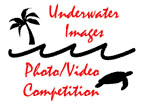Videolights
Jim Church's Cows
Part I
by Roger Roth
For many years the late Jim Church shared his expertise with underwater photographers. One of the best tools he created was using cows to illustrate his points to understanding photography. These barnyard lessons have been shared on many internet forums so I thought it would be appropriate to pass them on in this and the next two Videolights articles for those of you who haven’t read them. My thanks to Jim for his lessons, his mentorship, and his friendship.
Understanding Photography the Easy Way
–or-
Barnyard Banter About the
Basics.
PART I -- APERTURE & SHUTTER SPEED
How many cows pass through the gate
Let's begin with some simple, mental pictures of how aperture and shutter speed control exposure.
- Imagine that a farmer has two fields, one to your left and one to your right. Imagine a fence dividing the two fields, with a gate in the middle of the fence.
- One field is full of cows; the other field is empty, and the farmer wants to move a specified number of the cows to the empty field.
- To allow the cows to reach the empty field, the farmer must open the
gate. The wider he holds the gate open, the greater the number of cows
passing through during any given time.
Think of the width of the open gate as the aperture control of your camera: The wider the aperture (the wider the gate is held open), the greater the amount of light lighting passing through the lens during any given time. - The farmer has a second way to control the number of cows passing
through the gate: The longer he holds the gate open, the greater the
number of cows passing through at any given aperture (width of the opening).
Think of the amount of time the gate is held open as the shutter speed on your camera. The slower the shutter speed, the greater the amount or light passing through the lens at any given aperture. - Isn't having the "correct" number of cows passing through the gate much the same as having the "correct" amount of light passing through the camera lens? By golly, it is!
To sum up: The farmer has two ways to control the number of cows passing through the gate: how wide did he hold the gate open, and how long did he hold it open. With your camera, the width of the aperture and the shutter speed controls the amount of light passing through the lens.
In reality, the aperture and shutter speed controls of a camera are two separate parts, but the idea of "how many cows get through the gate," gives us a mental picture of how aperture and shutter speed controls work together.
PART II -- DEPTH OF FIELD
When Elsie (the Borden Cow) looked at another cow about 20 feet away, the closer cows and the distant cows didn't appear sharp to her eye (unless she shifted her direct gaze to a different cow). Her eyes are O.K.; she was having an in-body depth of field experience.
REAL WORLD EXPLANATION
When you focus your camera lens (with SLR viewing, autofocus or "guess and by golly") for a distant subject, the lens will focus a sharp image on the film for that distance. In addition, some of the space on your side of the subject, and some of the space beyond the subject will also be in reasonably good focus. This space (from in front to behind) is called "depth of field." In most situations, we want as much depth of field as we can get.
The high-numbered f-stops (such as f22) yield MORE depth field than the lower-numbered f-stops (such as f4). This is for technical reasons beyond the scope of the present discussion.
How do you remember which gives the greatest depth of field, high- or low-numbered f-stops?
Bovine explanation :
Elsie has a "never miss method"--she simply looks at the other cows in the field:
- If the gate is only opened a tiny bit, the cows are lined up "deep into the field" awaiting their turn to pass through the gate. Thus, Elsie sees that the cows are lined up deep in the field. ("Deep in the field" means lots of depth of field; clever little cows, huh.)
- If the gate is flung wide open, the cows don't have to line up so far, so the depth of the cows in the field is reduced.
Real world explanation (well, kind of):
Higher-numbered f-stops give greater depth of field than lower-numbered f-stops. To remember, think of the narrow gate opening and the cows lined up deep into the field. And when the gate is wide open, think of the cows not lined up so deep. (Okay, it's a hoky, slap-stick explanation, but if you can visualize it you'll never forget it.)
Depth of field and picture area
The smaller the picture area photographed, the lesser the depth of field. With extension tubes, for example, depth of field is in fractions of inches (or millimeters). How can you remember: Well--reaching for the bottom of the barrel--the cows can't line up as far in a miniature field.
Depth of field and focused distance--bovine explanation
When Elsie focused her eyes on a near cow, the closer and farther cows weren't in sharp focus. However, If Elsie focuses her eyes on a cow on the other side of the field, a greater number of cows appear sharp to her eye. (You can try this in the privacy of your own back yard by looking at near and far objects.) Thus, the farther the view, the greater the number of near and far cows that appear sharply to Elsie's eyes.
Depth of field and focused distance--real world explanation
- For reasons beyond the scope of this simplified presentation, the wider the angle of the lens (the wider the view that the lens "sees"), the greater the depth field at any given f-stop. To remember, think of the Elsie's views of the near and far cows.
- As for focused distance, the greater the focused distance, the wider the view that the lens sees (same as the above). To remember, think of Elsie's view of the cows at the other end of the field.
Depth of field, near and far--bovine explanation
If Elmer (a very tall cow) looks at the fence, some of the cows of his side of the fence appear sharp. However, a greater number of cows in the background--on the other side of the fence--appear sharp. All Elmer knows is that when he focuses his eyes on something far away, He sees more sharpness in the background than in the foreground.
Depth of field, near and far--real life explanation
If you focus your lens for infinity, one-third of the depth falls on your side of the focused distance (the fence) and about two thirds behind. However, is you get smaller and smaller picture areas, such as 1:1 (lifesize on film), the spread becomes half and half. For example, look at the close-up depth of field for the Nikon Close Outfit and the 80mm lens underwater. At f22, 4.7mm of the depth of field is on your side of the fence--5.1mm is on the other side.
Critter corner: The words cowfish, boxfish and trunkfish are used interchangeably. Some fish in the Indo-Pacific are box-shaped and called Boxfish. Some fish in the Caribbean are triangular-shaped and are called trunkfish. When a boxfish or trunkfish has at least one set of horns, they are called Cowfish.
copyright © Roger Roth, 2002 - 2011
Roger Roth is a roofer by trade and lives in Cincinnati, Ohio. But his passion is underwater videography and after several decades of learning how to shoot and edit he has evolved into a teacher and a photographic philanthropist. Roger is the founder of the annual international Underwater Images Photo and Video Competition. You may contact Roger at rroth2@cinci.rr.com.

